 |
|

|
 |
TABLE of CONTENTS
 |
First snow squall of winter contributes to multi-vehicle crash along I-94 |
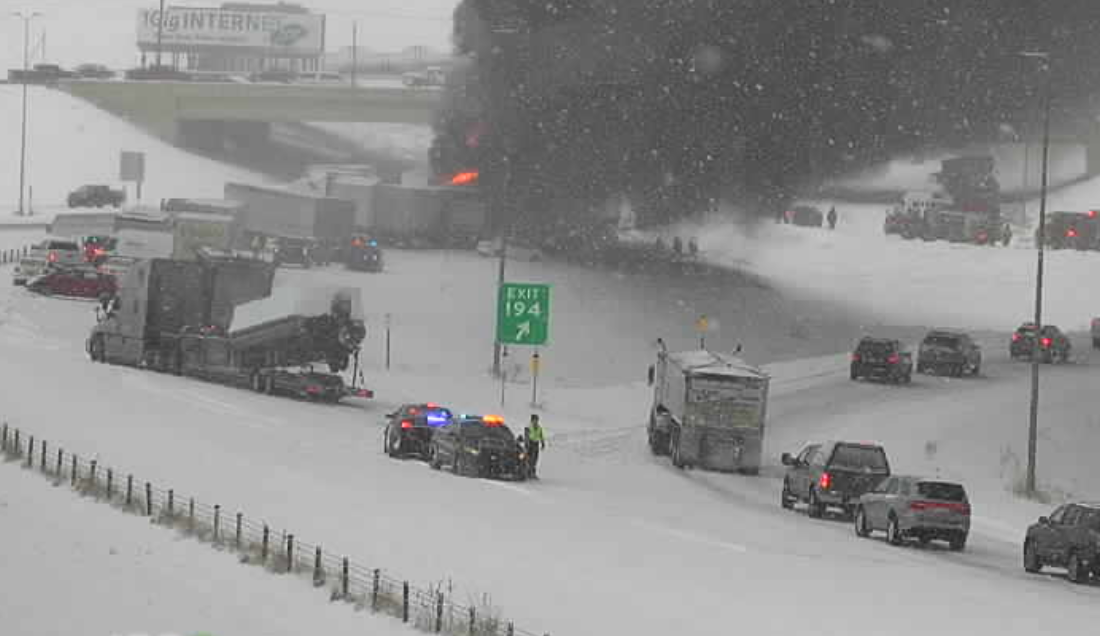
A 29-vehicle crash on I-94 outside of Monticello closed the freeway in both directions for several hours on Nov. 12. The incident remains under investigation, but a snow squall in the area at the time may have been a contributing factor. MnDOT traffic camera photo |
By Anne Meyer
A snow squall - a burst of heavy snow combined with strong winds that causes near-zero visibility - may have contributed to a 29-vehicle crash on Interstate 94 in Monticello Nov. 12.
This weather event marked the National Weather Service’s first snow squall warning this season for Minnesota.
The incident shut down all lanes of traffic for several hours. While the cause of the initial crash is still under investigation, poor visibility and challenging road conditions due to the snow squall made travel difficult at the time of the event. MnDOT crews in District 3 worked with the Minnesota State Patrol to clean up the crash areas and allow for travel to resume.
Snow squalls are rare in Minnesota, usually lasting an hour or less, and most often occurring in areas prone to lake-effect snow. This wasn’t the case for the Nov. 12 event.
A snow squall warning can trigger a Wireless Emergency Alert on a cellphone. If a warning is issued, motorists are encouraged to delay travel until conditions have improved. If behind the wheel, slow down and use extreme caution. It may be better to find a place to stop driving, but only if it is safe to do so.
|
|

|
 |
TABLE of CONTENTS
 |
Deer-friendly crossing aims to minimize animal-vehicle crashes on Hwy 14 |
By Mary McFarland Brooks

Coming soon to Hwy 14: deer, like these in Colorado, will be able to use a special wildlife-friendly crossing that’s included in the Hwy 14 expansion project under construction near Claremont in Dodge County. The tunnel will be the first of its kind in Minnesota. Photo by Colorado Department of Transportation |
Why did the deer not cross the road?
Answer: Because they went under it.
At least, that’s the plan with the special deer- and wildlife-friendly crossing being constructed as part of the Hwy 14 four-lane expansion project near Claremont in Dodge County. The 10-foot-tall by 9-feet-wide wide box culvert structure is approximately 200 feet long and connects under the four-lane highway from north to south. The tunnel will be the first of its kind in Minnesota. The Hwy 14 expansion is planned to open to traffic by fall 2021, with final construction concluding in spring 2022.
According to the Minnesota Department of Public Safety, there is an average of 1,449 vehicle-deer crashes on Minnesota roads each year, resulting in four deaths and 225 injuries.
“The main reason for the increase in vehicle crashes is that the deer mating season occurs in November,” said Christopher E. Smith, wildlife ecologist in the Office of Environmental Stewardship. “Increased deer movement, coupled with a reduction in daylight hours, increase drivers’ chances of encountering deer on roadways.”
MnDOT collaborated with the Department of Natural Resources to identify the location on Hwy 14 that separates two areas where deer cross seasonally. Deer use most of the landscape during the spring and summer, including areas on the north side of the highway. In the winter, many find shelter in the wooded ravines of the Dodge Center Creek watershed. Hwy 14 separates these two areas.
The DNR provided deer movement data and known migration route information to prioritize the underpass location.
In addition to the wildlife tunnel being constructed under Hwy 14, MnDOT has also constructed passage areas under bridges to allow wildlife to move along waterways. These areas have proven effective in keeping deer and other wildlife off roadways, Smith said. These “passage benches” are incorporated into bridge riprap, where they mimic game trails and allow wildlife to pass beneath bridges uninterrupted as they travel along the streambank.
In 2009, MnDOT funded a two-year study of the passage bench as a wildlife underpass. Researchers collected data at three locations in northern Minnesota, and the study showed 17 different vertebrate species using the benches, including black bears, foxes, bobcats and deer. Humans also used the crossings.
“Wildlife passageways are not only for the animals,” Smith said. “Their use increases driver safety through a reduction in wildlife-vehicle collisions. They are a win-win for motorists and animals.”
In a related effort, MnDOT is working to develop standard specifications for fencing to prevent wildlife crossing in areas where vehicle collisions are known to be an issue. Fencing will redirect wildlife to safe areas to cross, such as under bridges and through box culverts.
Watch out for deer
Here are some tips from the Minnesota Department of Public Safety on how to avoid deer crashes:
- Be especially cautious from 6-9 p.m., when deer are most active.
- Use high beams as much as possible at night, especially in deer-active areas.
- Don’t swerve to avoid a deer. Swerving can cause motorists to lose control and travel off the road or into oncoming traffic.
Watch for the reflection of deer eyes and for deer silhouettes on the shoulder of the road. If anything looks suspicious, slow down.
- Slow down in areas known to have a large deer population, such as areas where roads divide agricultural fields from forest land; and whenever in forested areas between dusk and dawn.
- Motorcyclists: Avoid night and low-light riding periods. A rider’s best response when encountering a deer is to use both brakes for maximum braking and to keep your eyes and head up to improve your chances of keeping the bike up. If a crash is imminent and there is enough space to swerve around the deer without leaving the roadway, use maximum braking and, just before impact, attempt a swerve in the opposite direction the deer is traveling. Riders are encouraged to wear full-face helmets and full protective gear to prevent injury or death in a crash. High-visibility gear can assist other drivers in seeing you better while making an evasive maneuver to avoid a deer or lying on the roadway after hitting a deer.
|
 |
|

|
 |
TABLE of CONTENTS
 |
State Engagement and Inclusion Survey seeks employee feedback |
Minnesota Management and Budget is asking all state employees to share their views in an Engagement and Inclusion Survey. The deadline to complete the survey is Jan. 8, 2021.
The survey takes about 15 minutes. The survey is emailed to work email addresses from Management Analysis and Development (mnit@webhost.snapsurveys.com). The survey link is unique to each employee; do not forward these emails to anyone else.
Enterprise Talent Development, part of Minnesota Management and Budget, is leading the survey. Full results are expected by next year. Learn more about the survey here.
The survey is private. Each agency will receive survey results with all identifying information removed. After the survey results are compiled, MnDOT will receive the results and share them with employees. Each state agency will use the feedback to create action plans.
Employees who prefer a text-based version of the survey (for example, those using screen readers), select the “text only” link on the center of the top of the survey page. Contact MAD at 651-259-3800 or at management.analysis@state.mn.us for other accommodations.
|
| |
|

|
 |
TABLE of CONTENTS
 |
Annual electronic storage cleanup open until Jan. 1 |
By Joseph Palmersheim
Save, file or delete?
MnDOT offices and districts are encouraged to eliminate excess email and shared drive files as part of an agency-wide clean-up effort during the month of December. The clean-up supports data governance across the agency by disposing of information that is no longer needed and storing information in the correct place.
“We really appreciate the time that will be set aside to make progress on shared drive files and email clean-up,” said Nancy Daubenberger, deputy commissioner and chief engineer. “Reducing the number of files we save will help mitigate risks associated with data practices and legal issues. Also, cleaning up data on a regular basis helps MnDOT reduce storage costs and be fiscally responsible.”
With storage costs at around 24 cents per gigabyte space, saved files can add up quickly.
“We are charged by the gigabyte per month of usage on all of the shared drives, like N, P or any other letter,” said Charles Stech, records manager, Chief Counsel Office. “For example, I have heard of a shared drive in the districts that was in the multi-terabyte range. Each terabyte is equal to 1,000 gigabytes. At 24 cents a gigabyte, one terabyte of storage space can cost $2,880 a year.”
The MnDOT retention schedule sets rules for how long records must be kept and what happens at the end of their lifecycle. A record is information that documents MnDOT business decisions or transactions and is designated in the agency's retention schedule. It can take any format – electronic data, paper, even physical artifacts. Copies, drafts, meeting agendas, etc. are not records.
Steps to take:
- All district engineers and office directors will schedule four hours for their business areas to review Outlook and electronic files between Monday, Nov. 30, 2020, and Friday, Jan. 1, 2021. During this time, all employees need to:
- Review all emails and electronic documents to determine whether they are records.
- Delete all outdated non-records from their Outlook (inbox, sent items, deleted items) and shared drive.
- Delete or dispose of records that have reached the end of their retention period (refer to the retention schedule).
- Move all records to their designated storage location (shared drive, eDOCS, ProjectWise, etc.). Do not store non-business related personal files or data on MnDOT resources.
- Record clean-up activities on timesheets as:
- Project ID - T0008102
- Activity Code/Source Type – 0023
- Fill out a Records Destruction Report listing all records you delete. State government agencies are required by law to permanently retain a list of destroyed records. Non-records do not require a Records Destruction Report.
In a change from contests from past years, two awards will be given this year. One award will go to the office or district that reduces its email storage by the most percentage points, and the second will go to the office or district that most reduces its shared drive storage.
Data storage will be measured each week, with a final tallying coming from percentage changes made by Jan. 4, 2021. Storage levels will be posted on the Information Governance Program SharePoint, and the winners will be announced in January. Last year, the Office of Research and Innovation deleted 25.94 percent of its emails.
Previous “Golden Hard Drive” winners:
- Research and Innovation Office - fall 2019
- District 6 - spring 2019
- Office of Transit and Active Transportation - winter 2018
- Office of Civil Rights - spring 2018
- Office of Environmental Stewardship - fall 2017
- Office of Freight and Commercial Vehicles - spring 2017
- Office of Civil Rights - fall 2016
Contact Charles Stech for more information.
|
| |
|

|
 |
TABLE of CONTENTS
 |
Leadership Development Program open enrollment starts Dec. 7 |
Open enrollment for Group 16 of the Leadership Development Program runs Dec. 7, 2020, through Jan. 15, 2021.
This program allows all employees to work on core competencies and attend learning opportunities that fit their work schedule. More than 1,700 employees have participated since LDP started in 2012.
Participants in this 11-month program will learn valuable leadership skills, network with other MnDOT employees, gain exposure to different MnDOT offices, and learn from professionals.
“The LDP program provided me with learning opportunities that increased my knowledge and understanding, as well as improved my confidence,” said Brianna Alsides, Training and Development specialist, LDP Group 13 Alumni. “Being able to participate with other MnDOT employees striving towards a common goal of personal development is exciting to be part of and will benefit the organization as a whole. As an alumni of the program who has benefited greatly, I encourage anyone who may be interested to sign up so they too can improve on skills and create new and exciting networking circles.”
Group 16 begins March 1, 2021.
To learn more about the Leadership Development Program and how to enroll, visit the LDP website or attend a Skype information session (dates listed below). To register for an info session, send an email with the session date to Barbara Vang.
Skype information sessions:
- Dec. 9 - 9 a.m.
- Dec. 10 - 10 a.m.
- Dec. 17 - 3 p.m.
- Dec. 22 - 1 p.m.
|
| |
|

|
 |
TABLE of CONTENTS
 |
Office of Civil Rights mourns loss of George Costilla |
By Joseph Palmersheim
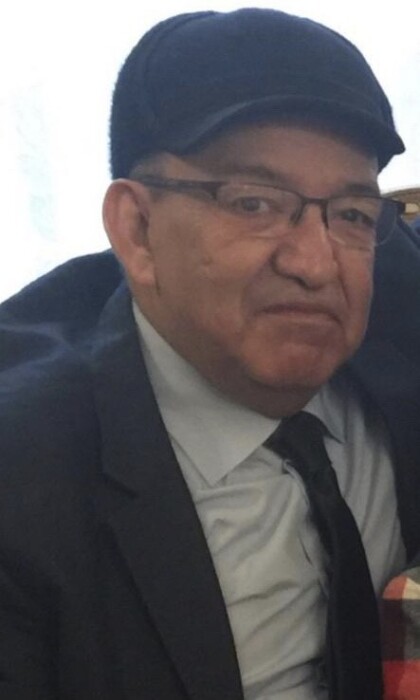
George Costilla. Submitted photo |
George Costilla, business development advisor with the Office of Civil Rights, died Thursday, Nov. 12.
Costilla worked for MnDOT for more than eight years, serving as a mentor and adviser to small businesses. Prior to joining the agency in April 2012, Costilla spent more than 17 years as the owner of a construction management company in Texas, and also served as an energy efficiency consultant.
Fellow employees described Costilla as someone who liked helping others.
“Big Daddy’s was one of his favorite lunch spots,” said Joyce Brown-Griffin, Small Business Program specialist. “One time, there was a woman crying in the restaurant. George went over to see if she was OK. During their conversation, George learned that the woman was a small business owner, and he ended up working with her to get her certified as a DBE.”
Brown-Griffin described working with Costilla as “like having a brother around,” and said she would miss the laughter the two shared together.
Thomas Mebrahtu, program specialist, said Costilla was passionate about the DBE program because he, as a previous small business owner in the construction industry, understood the challenges that small businesses face and wanted to provide access to solutions.
“George was a successful small business advisor who approached the job from a coaching standpoint, with the end goal of ensuring the small business owner gets the skills necessary to thrive long after he helped them,” Mebrahtu said. “He was even available at night, and when small businesses called for assistance, he would be there for them. I will miss his outstanding expertise, passion and compassion for small businesses owners. He shared his great experience with the team and we will miss his incredible knowledge.”
Services were held Nov. 17. Costilla, a U.S. Marine Corps veteran, was buried at Fort Snelling National Cemetery.
Obituary
|
| |
|

|
 |
TABLE of CONTENTS
 |
Latino ERG video recruits Spanish-speakers |
By Joseph Palmersheim
MnDOT’s Latino American Resource Group recently developed a Spanish-language video to broaden recruitment efforts for the agency.
With in-person events not possible due to COVID-19, the group’s Community Engagement Subcommittee (Cindy Charles, Investigations; Lena Garcia, Human Resources; and James Pontius, Employee Development) met to discuss how to reach out to the Latino community. The result is a short video that is available on YouTube.
“Communidades Latinas Unidas En Servicio started hosting virtual career fairs in Spanish, so we decided we wanted to create a MnDOT recruitment video in Spanish,” Garcia said. “With the help of the subcommittee, LAERG member Alejandro Molina Mendoza translated the information from English to Spanish, and Joel Wenz in Video Services put our video together. We think we came up with a great video.”
MnDOT was the only state agency to have a video in Spanish at the last CLUES Virtual Career Fair on Oct. 27, according to Garcia. In addition, MnDOT’s LAERG Chair Christian Guerrero spoke to the participants in Spanish, while recruiters from other agencies required a translator. Garcia said she is proud that MnDOT made the effort to speak to candidates in Spanish.
“As Latinos, we think it is important to reach the Latino audience,” Garcia said. “Also, part of our Latino American ERG Work Plan is to focus on community engagement, recruitment, retention and professional development. We have received positive feedback so far and will utilize this video as much as possible. CLUES has also shared the video with their career counselors and potential candidates.”
More information about MnDOT’s Latino-American ERG
|
| |
|

|
 |
TABLE of CONTENTS
 |
Winona Bridge rehabilitation project wins national award |
By Joseph Palmersheim
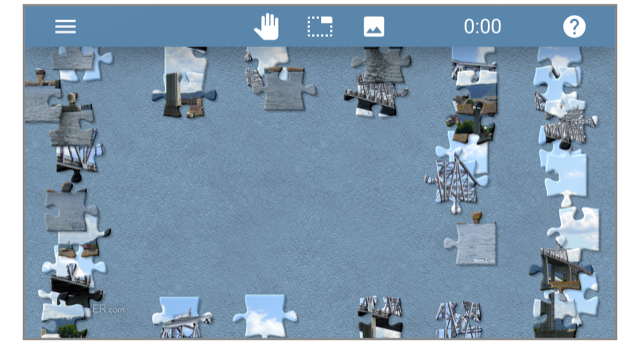
The Winona Bridge was the subject of a digital puzzle made by the American Institute of Steel Construction. The puzzle was part of a series of recent honors for the project winning a merit prize for rehabilitation. Submitted photo |
The American Institute of Steel Construction recently showcased the Winona Bridge project as the winner of this year’s Prize Bridge Merit Award for Rehabilitation.
The 2,291-foot bridge was highlighted on aisc.org, in the National Steel Bridge Alliance weekly bulletin, in AISC social media, and as a digital jigsaw puzzle released Friday, Nov. 27 (please note: the puzzle link may not function on work devices due to MNIT network settings).
MnDOT learned about the award win in January 2020. The award plaques will be mailed out this month. Plans originally called for the awards to be presented at an AASHTO Committee on Bridges and Structures conference in June.
Originally built in 1942, the Winona Bridge was rehabilitated from 2014-2019, which AISC estimated added 50 years of service life to the structure.
Keith Molnau, major bridge projects engineer, Bridge Office, said the project was challenging for both MnDOT and its partners, with a “long road” ending in an acceptable solution for all involved.
“We had much of MnDOT’s current leadership engaged with this project on the project management team, working with District 6, the city of Winona, and many other stakeholders to get this project completed,” he said. “It’s great that NSBA chose to feature the Winona Bridge to celebrate the success of MnDOT’s first Construction Manager/General Contractor project.”
Six judges evaluated more than 50 bridge projects across the country for the 2020 awards. The bridges were all built of structural steel produced and fabricated in the U.S. They are all located in the U.S. (50 states, the District of Columbia and all U.S. territories), and opened to traffic between Jan. 1, 2017, and Dec. 31, 2019.
“The judges considered a variety of factors, including innovation, economics, aesthetics, design and engineering solutions, in selecting winners,” said Dani Friedland, ASCI director of Marketing Communications. “In the case of the Winona Bridge, they were particularly impressed by the blend of creative, elegant engineering and the team’s careful respect for the existing historic design.”
|
| |
|

|
 |
TABLE of CONTENTS
 |
Annual Toward Zero Deaths poster brings partners together to improve traffic safety |
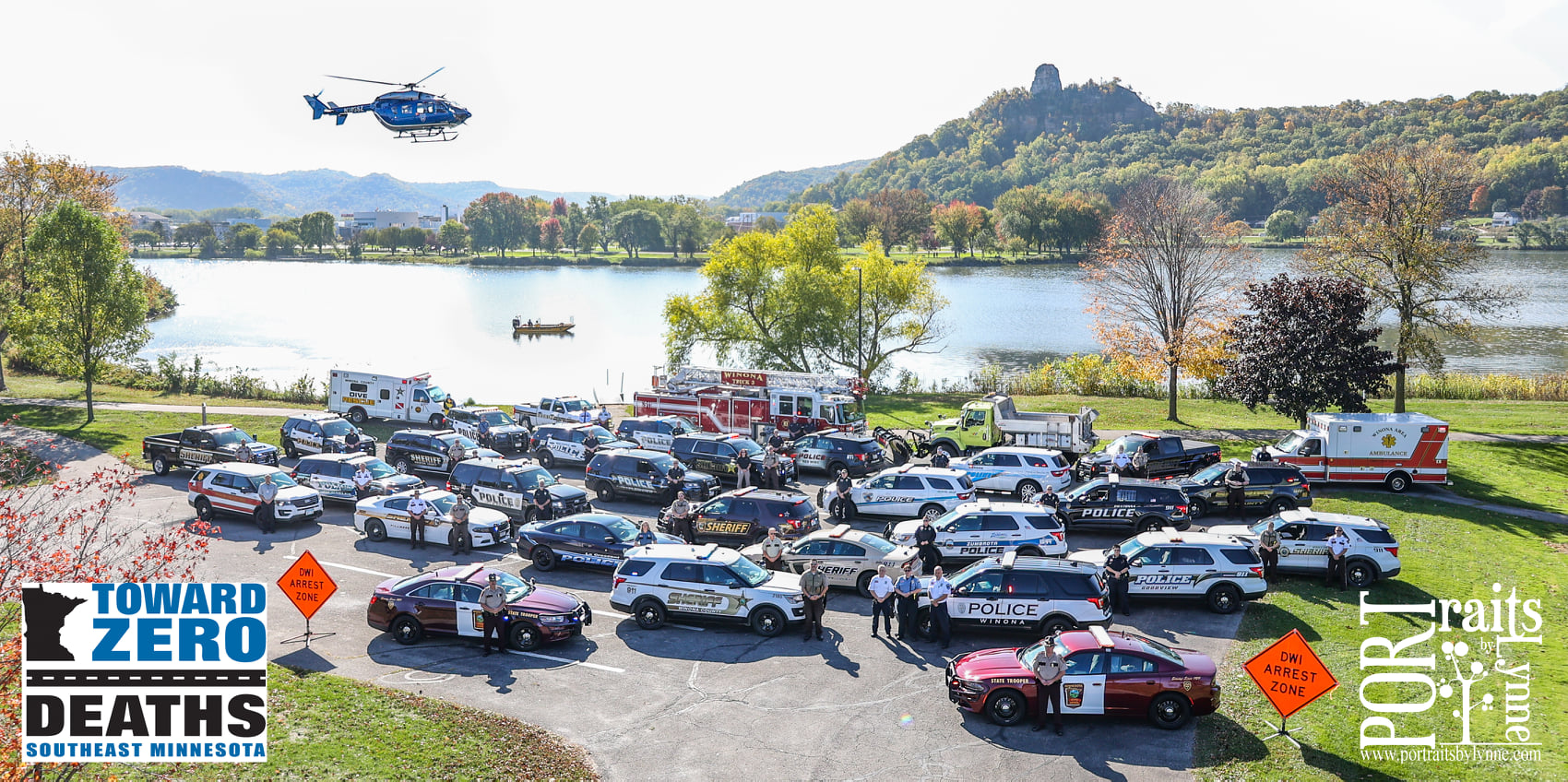
This year’s Toward Zero Deaths poster photo includes members from 31 county and city law enforcement, fire, rescue and public works agencies. Photo by Lynne Port |
By Anne Meyer
They say a picture is worth a thousand words, but it takes more than words to create an annual Toward Zero Deaths poster in District 6.
This year’s photo required the coordination of 29 squad cars, two ambulances, a fire truck, snowplow, rescue boat, helicopter - and a very brave photographer in the bucket of a boom truck.
“Winona County was the perfect location for our first fall photo because it allowed us to get creative and showcase the changing leaves,” said Jessica Schleck, D6 Towards Zero Deaths coordinator.
The annual poster idea began 14 years ago to help kick off the July speed enforcement campaign in southeast Minnesota. It recognizes the “4Es” that work with TZD to help make the safety program happen: education, enforcement, engineering and emergency medical/trauma services. Due to the pandemic, this year’s photo shoot was postponed from May until October, meaning the poster would be ready for distribution during the holiday DWI enforcement campaign instead.
The location rotates each year, allowing all 11 counties in District 6 to host the photo shoot. It’s also a great way for different agencies to come together, strengthening relationships beteen the different traffic safety stakeholders, Schleck said.
“It takes teamwork to change behaviors behind the wheel and improve traffic safety,” she said. “This poster helps us show the various partners that work with TZD and it helps build partnerships amongst the stakeholders in our region.”
Besides MnDOT, this year’s photo includes members from 31 county and city law enforcement, fire, rescue and public works agencies.
More information on Minnesota’s TZD program
|
| |
|

|
 |
TABLE of CONTENTS
 |
On the Job: Maria Zappa enjoys topographic field work, plowing in District 6 |
By Rich Kemp
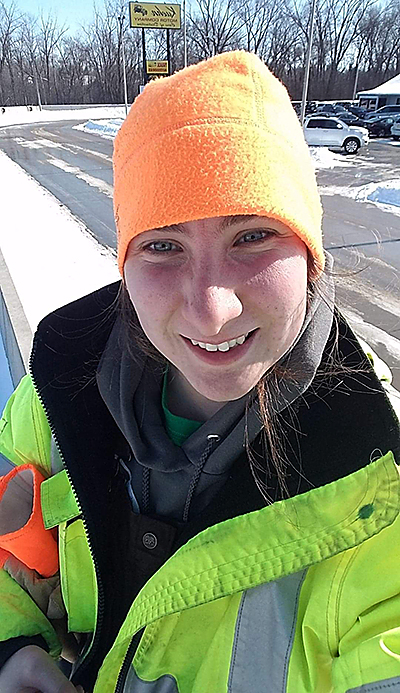
Maria Zappa. Submitted photo |
Maria Zappa is a surveying field technician in District 6. She started at MnDOT as student worker. After graduating from Dakota County Technical College in 2018, she was hired in a permanent position to work in design for about a year and then switched back to surveys. In addition to surveying, Zappa also helps the maintenance crew with snowplowing in the winter.
What do you do in your job?
We do a variety of things. The main part of our work is topographic surveying, which means we collect field data for upcoming projects, located section corners and property corners. We have a boat called the Z boat, which we use to collect data using sonar. In the summertime, we also do a little bit of construction staking.
What is your favorite part about your job?
I like that every day is different and no job is the same. I enjoy getting outside of the office and doing hands-on work. I enjoy the construction staking side of things because you can see the project being built in front of you.
What are the biggest challenges?
I would say the biggest challenge is working during the winter time outside in unpleasant conditions. It might slow us down, but we are always up for the challenge.
How do you like driving the snowplow?
I enjoy snow plowing. Each snow event is different, so it keeps me on my toes. It can be stressful at times when you can’t see the road, but it is also a rewarding experience to know that you were part of the team that helped clean up the road and got things back to normal. It is definitely a team effort to get the job done.
What kind of changes have you seen in your job?
The software and technology that we use in the field. I started using Trimble and now we switched to Leica for data collection.
Has your job changed a lot because of COVID-19?
I would say yes. I miss seeing everyone in the office. Sometimes it can be quite challenging to find the correct information you need because nobody is in the office. So you have to call more than one person to get the answer. The nice part is once you get out into the field it can be an escape from reality and you can just do your job.
Do you or a co-worker have an interesting job to share with readers? Send us your ideas, and we’ll contact you for more information.
Recent employee profiles:
|
| |
|

|
 |
TABLE of CONTENTS
 |
Serving as an election judge is a meaningful experience |
By Amber Dallman, Office of Transit and Active Transportation
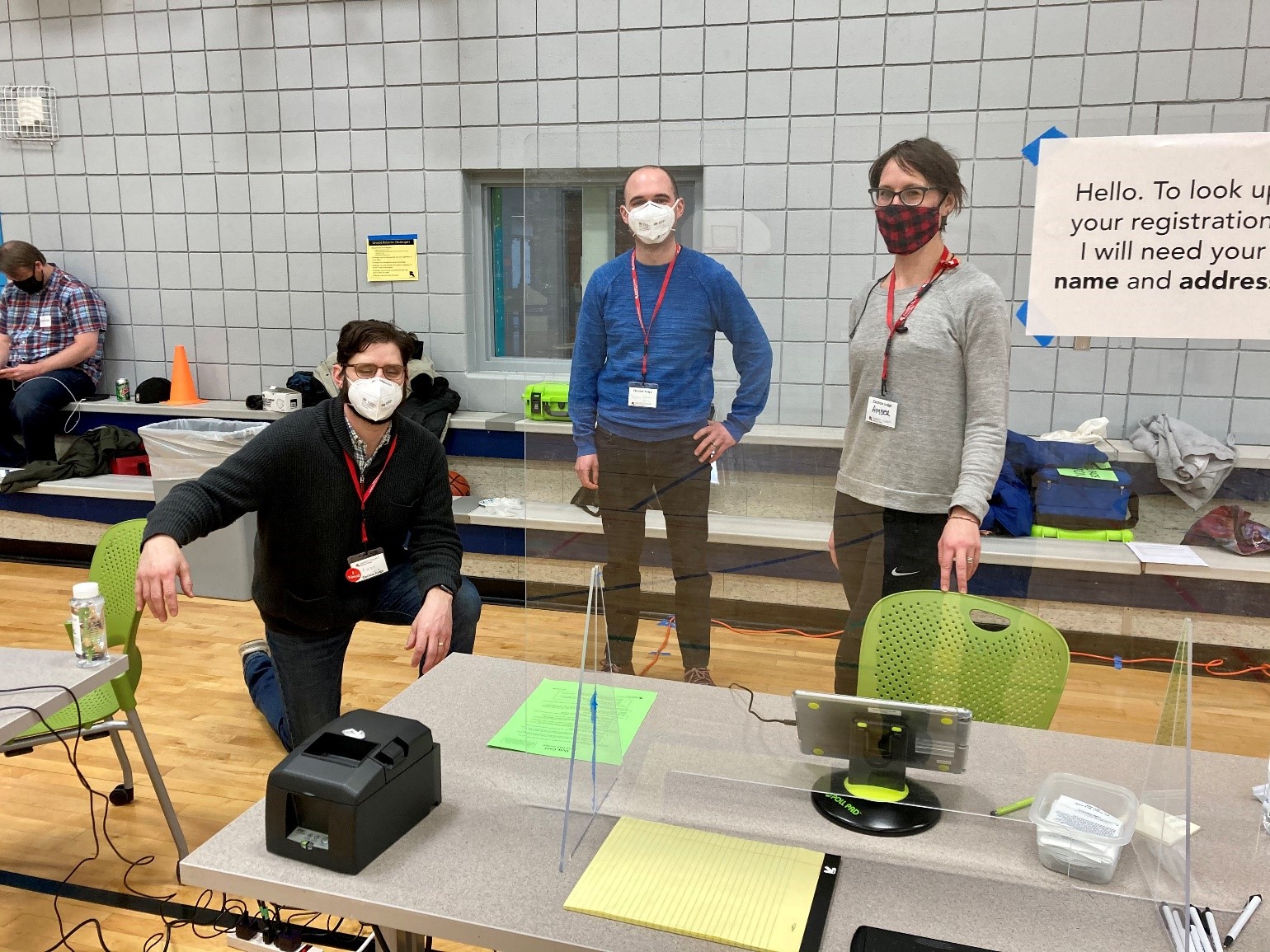
Andy Trcka, Thomas Johnson-Kaiser and Amber Dallman recently served as election judges in St. Paul. One benefit of serving as an election judge in one’s home community includes being able to walk and bike to the polling site, which all of them did. Submitted photo |
My alarm went off early on Nov. 3 – at 4:45 a.m., to be precise.
I needed to get myself out the door and to St. Paul Precinct W2-P05, just over a mile from my house, by 5:30 a.m. to serve as an election judge. I had my bag packed to be there until 9 p.m. The brisk cold air helped wake me up while I biked over to the polling location.
Once there, a crew of election judges were busy setting up to prepare for the polls opening at 7 a.m. There were signs to post, tablets and ballot machines to set up, oaths to take, and surfaces to constantly sanitize.
Fortunately, I was in good company. Two other election judges were also MnDOT staff members: Thomas Johnson-Kaiser and Andy Trcka. This was the first time the three of us had worked as election judges in a national presidential election. We weren’t the only ones – I heard about other MnDOT colleagues serving in other parts of the state, too.
This made me wonder: what prompted people to serve as election judges during a pandemic? And what did they think others should know about working an election?
I followed up and heard some consistent themes.
First, I asked what prompted them to become an election judge? Here’s what they shared:
- “Due to the COVID-19 pandemic, I heard there was a need for election judges. I am not part of a COVID high-risk population so I wanted to help out to ensure we can continue to have safe, free and fair elections.” - Thomas Johnson-Kaiser, Research and Innovation
- “I was looking for ways to volunteer for the election when I heard piece on NPR asking people to serve as election judges. After hearing that I felt it was my duty to volunteer.” - Andy Trcka, Enterprise Development
- “My first time was in August and then again in November, thanks in part to a nudge from some coworkers who had signed up. I was thankful to get the time away from work and the support from my team of my absences those days. Additionally, I heard that in Olmsted County, where I live, they were in need of judges because many were high risk and not able to participate this year.” - Kelly Corbin, Transit and Active Transportation
- “I have been an election judge in Minneapolis since 2014. I was first inspired to be an election judge because I liked the idea of helping people participate in the civic process in a fair and unbiased way.” - Emily Houser, Sustainability & Public Health
Their responses resonated with me and are similar to what prompted me to sign up. Regarding what others should know about being an election judge, I heard more inspiring responses:
- “It was much easier than I imagined, and people voting were very thankful and kind to the judges. Celebrating someone’s very first time voting is a really cool experience, as was seeing the kiddos who said they’d see me again when they turn 18.” - Kelly Corbin
- “Serving as an election judge allowed me to see how an election works, but more rewarding than that was the opportunity to help people vote. I personally registered 15 new voters, one of whom was a recent immigrant so excited to vote she was crying. I also spoke with a couple elderly folks who told me this will probably be their last election. What an honor to help anyone vote, especially someone who might be voting in their last election.” - Andy Trcka
- “Being an election judge is a great opportunity to learn what goes on behind the scenes for an election. Volunteering was educational, fun and an excellent way to support your local community.” - Thomas Johnson-Kaiser
- “It is easy to get started as an election judge, and it’s interesting to learn about all the thought and preparation that goes into how elections are administered. I’d recommend it.” - Emily Houser
I echo the sentiments of my colleagues and fellow election judges. Participating in the process helped me appreciate the details and logistics of an election.
I was surprised to learn Minnesota State Statute 204B.195 provides individuals with time off from to work to serve as an election judge. In addition, the union contracts call this out as well. So, if you’re interested in learning about and supporting elections in Minnesota, consider becoming an election judge in your community. It can be a long day, but you’ll likely be in great company. Learn more about being an election judge.
|
| |
|
| |
|



